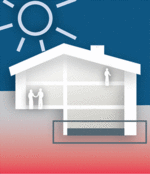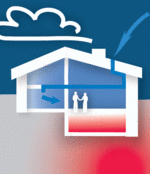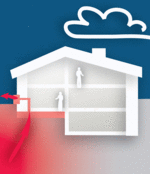There are straightforward, low-cost means available to protect a building from excessive radon exposure. Preventive protective measures in the course of planning of a new building or renovation work are preferable to subsequent remediation.
Each measure relates to one of the three basic principles of radon protection:
- Radon is prevented from entering the building
- Radon is actively removed before it enters
- Radon is conveyed out of the building
The most commonly used methods for reducing radon exposure are described below:
Preventive protective measures for new buildings and renovations
Basic measures
Systematic implementation of the radon protection measures described in SIA Standard 180/2014 on heat and damp insulation in buildings. Particular care should be taken to reduce underpressure in the building.
Additional radon protection measures
Additional protective measures are recommended in the following risk situations:

- The probability of exceeding the reference level is more than 10% (radon map)
- The building has a cellar with a natural floor or occupied rooms in contact with the ground
Additional radon protection measures:
- Additional sealing outside or inside the building (e.g. radon barrier membrane or airtight cellar door)
- Controlling air flows (e.g. with radon drainage below the foundation or controlled air changes in occupied rooms)
Specific recommendations for new buildings
No two buildings are identical. Consequently, when planning a new building it is impossible to predict the radon gas concentration. However, preventive measures in new buildings are much less costly than subsequent remedial action.
Precautions for new buildings (PDF, 1 MB, 01.11.2019)Note: This brochure is based on the 1994 Radiological Protection Ordinance, which has since been amended. Since 2018 a new reference level of 300 Bq/m3 has applied for the concentration of radon gas in occupied buildings. The radon map of Switzerland has been revised on this basis.
Concreting the basement: foundation slab
In order to prevent radon from entering the building, the building envelope that is in contact with the soil must be sealed. This requires a continuous foundation slab and walls that are in contact with the soil should be constructed with concrete of the exposure class XC2. Moreover, air-tight inlet and outlet ducts for cables, water, waste water etc. are very important e.g. with a pipe duct system (PDS).
Soil aeration below the building:

This measure helps to create a reduced pressure, with respect to the building, under the foundation slab. This method is somewhat complex but proves very effective, and is mainly recommended when the building is planned to have living spaces in contact with the soil. Radon is drained away by the use of actively or passively ventilated, perforated, 10 cm diameter pipes laid under the foundation slab.
Air circulation under the house:

A rather rare measure in newer buildings is the construction of a cavity space under the foundation slab in buildings without a basement. This cavity space is then ventilated or vented either passively, by judicious placement to the prevailing wind direction, or actively, by means of a ventilator.
Specific recommendations for renovations
The best way to get a precise indication of the necessity of measures to protect against radon before renovation work is to measure radon beforehand. This applies particularly when it comes to converting basement floors into living space. The concentration of radon also tends to increase when windows are changed.
The effect of retrofitting thermal insulation (PDF, 1 MB, 01.11.2019)Note: This brochure is based on the 1994 Radiological Protection Ordinance, which has since been amended. Since 2018 a new reference level of 300 Bq/m3 has applied for the concentration of radon gas in occupied buildings. The radon map of Switzerland has been revised on this basis.
Radon remediation in existing buildings
If appropriate measurements have shown that the average radon concentration over one year is greater than 300 Bq/m3 in an existing building then radon protection measures should be initiated. The most suitable remedial method depends strongly on each individual case and should be clarified by a qualified radon consultant. Important: Subsequent to each remedial radon treatment, there is an obligatory control measurement!
Remediation measures in existing buildings (PDF, 1 MB, 01.11.2019)Note: This brochure is based on the 1994 Radiological Protection Ordinance, which has since been amended. Since 2018 a new reference level of 300 Bq/m3 has applied for the concentration of radon gas in occupied buildings. The radon map of Switzerland has been revised on this basis.
Sealing the building sections that come into contact with the soil:

A continuous foundation slab and air-tight conduits for cables, water, waste water etc. can also be realised later. These seals prevent the ingress of radon from the subsoil. In many cases, however, these improvements are not sufficient and have to be complemented by further measures.
Mechanical ventilation:

There is the possibility to install a ventilator in the cellar so as to create an adequate air exchange. If the whole building is mechanically ventilated by a controlled ventilation of the living space, care must be taken that the fresh air intake from outdoors is located at least 1.5 meters above ground level.
Reduced pressure system under the foundations (radon wells):

Radon can be removed before it even enters the building using a radon sump under the foundation. For this, a hole is drilled through the foundations and a shaft (ca. 0.5 x 0.5 meters) is excavated. The ground air is then carried away out of the shaft by a ventilator through a discharge pipe.
In most cases, suction at one place suffices (for example in the center of the house or in a room with a high radon concentration).
Last modification 04.12.2020
Contact
Federal Office of Public Health FOPH
Division of Radiological
Radiological Risk Section
Schwarzenburgstrasse 157
3003
Bern
Switzerland
Tel.
+41 58 464 68 80

